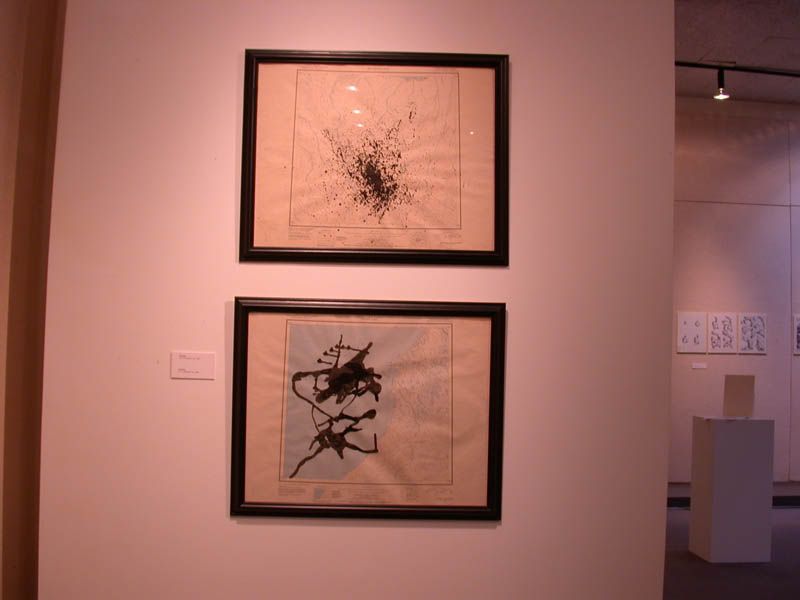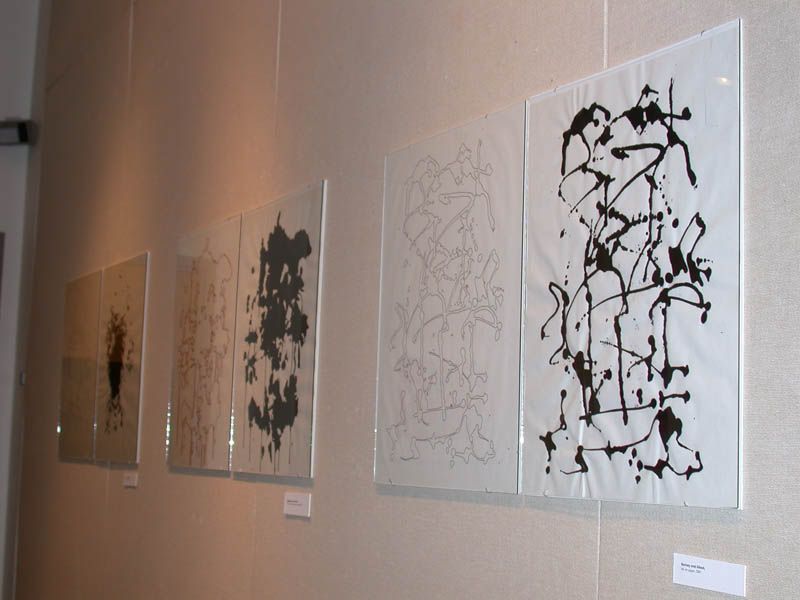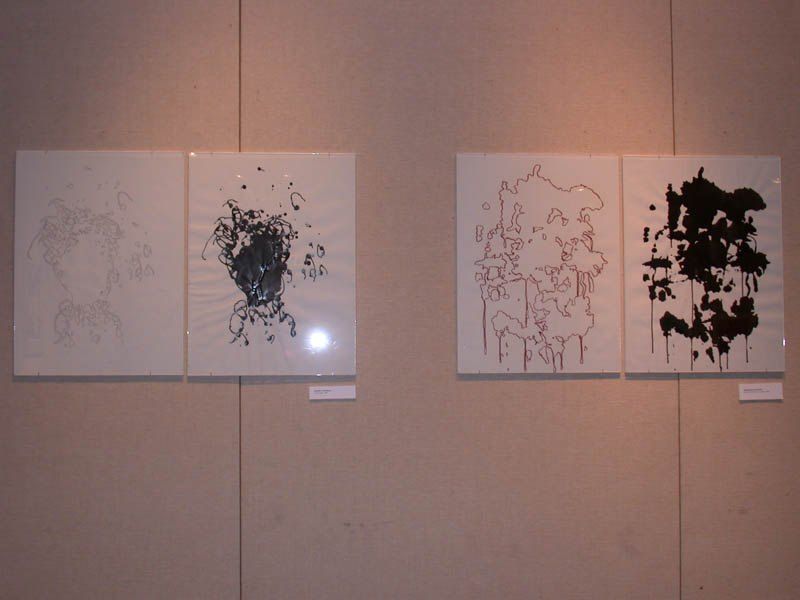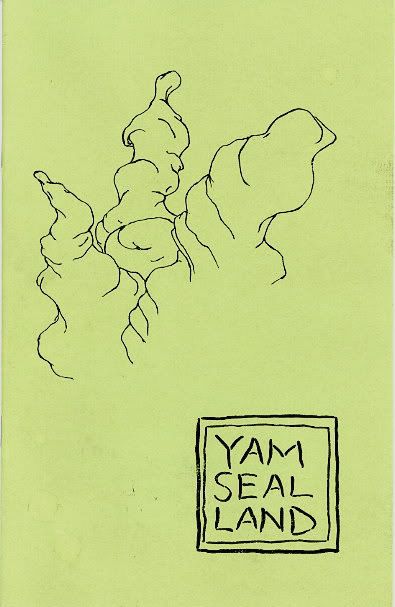This is, actually, news of some relevance to those interested in abstract comics. The TCJ board was, effectively, the birthplace of the Abstract Comics anthology, or at least the birthplace of the idea for it. Please allow me to give a brief history of its conception, as seen from my point of view.
Circa 2000/2001, I returned to comics, a medium I had largely given up on not so much in disgust as in boredom in the early 1990s. I came back with the idea of teaching a course on the subject, though without much interest at that point in returning to cartooning. My work by that time had gone as far from representation as possible, and I could not see (not that I was looking for it) a way of reintegrating that with a comics format:



(top image, a couple of pieces from 1998; bottom two images from 2000-2001; installation views from my 2005 show at the Belknap Gallery, University of Louisville.)
Now, in retrospect, I had done sequences of abstract drawings in my sketchbooks as early as 1988, and then again in the late '90s. (Some of the latter I later integrated into my 2003 minicomic, Blots.) But I wasn't thinking of them as "abstract comics" yet--I just wanted to explore this kind of gradual transformation of form, and/or the dialogue of form to form from page to page.
I first began thinking of abstract comics as a concrete possibility during a discussion with Domingos Isabelinho on the TCJ board in the summer of 2002, on a thread with the rather awkward title, "Is there a Hemingway or Faulkner of comics?"--or something of the kind. (Since the thread was never archived, and I didn't think to save it in time, I don't have it to refer to. I have since asked here and there to see if anyone had saved it, but no one seems to have. If you, reading this, happen to have done so, please email me!) Obviously the thread was about the medium's literary ambitions, but it soon turned to artistic ambitions of other kinds. I don't remember which of us, Domingos or myself, brought up "abstract comics" first, but I soon found myself arguing about how they could be done, and comparing them to the sequential pieces I had done in the past. At that moment, about the only examples I could think of were some pieces by Pierre Alechinsky, which I had adored since college (one of which I illustrated in the introduction to the anthology), and the Crumb piece from 1967 with which the anthology opens. Only later, though not much later, did I find Gary Panter's 2000 one-pager, first published in the first volume of Danny Hellman's Legal Action Comics, which I also ended up reprinting in the anthology, and which, along with the Alechinskys, I took as encouragement that it could be done.
So, in late 2002, I found myself trying my hand for the first time self-consciously at an "abstract comic." This, if I remember correctly, was the first result I was happy with:

(It too was later included in Blots.)
At that time I did not even have a scanner yet, let alone have any idea how to post images online, so I could not get any feedback on it via the internet. In September 2003 I put together my first two abstract (or, in the case of the second title, near-abstract) minicomics, Blots and Yam Seal Land.


I was quite surprised to find, after simply announcing the titles online--specifically, on the message board, as I did not have a site or a blog yet--that I got a good response, and I ended up selling or trading most of my run of one hundred copies each. For this, I am still grateful to the institution of the TCJ message board: as an unknown artist, I nevertheless could get enough word-of-mouth response to distribute my self-published pieces.
Around this time, as I started bringing up the topic of abstract comics more and more on the board--which was at the time my sole day-to-day link to the alternative and art comics community--I met a few sympathetic souls, especially Mike Getsiv, who himself began to try his hand (or had already done so? Help me with the chronology here, Mike) at abstract comics.
I wish I had saved those early discussions. I didn't, but I have saved a thread from June 2004--titled "New Abstract Comics," and from which I will quote for the remainder of this post--which I initiated by posting (I had finally figured out how to do so!) the first page of "The Cave," which I had just finished:

I also posted this two-pager, which, in a slightly revised format, was later published by Ibn al Rabin in "Bile Noire" 16 (my first "professional" comics publication):


I was glad to get positive responses from posters Patrick Stewart, Ben Fisher, Raymond Tan, Shane Durgee (all of whom I seem to have lost track of, even though the latter three also ended up trying their hand at abstract comics soon after.) Probably my favorite comment was the following:
shane durgee
posted June 07, 2004 09:27 AM
... if the admins lock down this thread we'll finally know what is and isnt comics.
While Ben Fisher interjected:
ben fisher
posted June 08, 2004 04:59 AM
It makes me happy to know that other people make comics like this.
(So I suppose Ben had already been making similar comics? I did see an excellent page or two by him, and I later tried to contact him to include his work in the anthology, but somehow it never worked out.)
It was really on the TCJ board that I began elaborating an early theory of abstract comics—-in response to questions and criticisms, and mainly with reference to my own pieces. In reply to a question from Patrick Findlay, who felt he could not see the sequence in the image, I wrote the following:
Andrei Molotiu
posted June 07, 2004 02:03 PM
...
Patrick--I don't know about "story," but I intended a certain "sequence" just by having some of the forms move down and to the right, others seem to progress from panel to panel, and finally establishing a certain rhythm of recuring motifs through color. I also meant to have it seem to play with things like layout (suggesting a regular 3x4 grid, then breaking it), but doing it kind of vaguely.
I don't really know if you can get what it's "about" if you squint, but squinting I'd say helps when looking at other, more straight narrative comics: I've always been fascinated by the formal, abstract rhythms that underlie them, and that still remain fascinating even after you know the stories by heart.
Later, in response to another query (which turned out to be nothing but trolling, though I did not know that at the time and I answered in earnest) I elaborated in detail on my procedure and how I viewed abstract comics to function:
Andrei Molotiu
posted June 08, 2004 12:23 AM
I'm not sure I feel like explaining my work if it's not clear at first, but since I was asked here are a few replies. Please understand that I was working more viscerally (to borrow a term from Jerrold) than conceptually, so what you will read below may be secondary elaboration.
I have always been fascinated by the tension, in some of the best comics (from Little Nemo to Panter) between the reading of a comics page as a l-to-r, top-to-bottom series of panels, and the reading of the layout as a single composition. To some extent, that tension was what I was attempting to regain here. The image was from the beginning designed as a 3x4 grid of abstract shapes; I later softened the bordering lines in photoshop, united some of the shapes, etc, but I think the separation into the twelve panels is still clearly visible. I did not want to put more distinct border frames in, as that would have worked against the sense of morphing I was going for. I was not necessarily working with a planned sequence (a to b to c) as I was designing the whole page, but with definitely a sense of sequence and motion from panel to panel. Let me call that sense "sequential energy." I have been making abstract paintings since art school. In the same way that when working on an abstract composition you work with shape, but without the representational meaning of that shape, so here too, I was working with shape plus sequence, or rather "sequential energy," but without a representational meaning for either those shapes or a "narrative" (as in "story," "plot") meaning for that sequential energy.
For me, as I was designing it, the first two rows clearly had a traditional 1-2-3 (next row) 4-5-6 sequence. Then I united panels 7 and 10, 9 and 12, etc, to some extent to make that sense of sequential energy more complex. In panels 1-6, at least, color is designed to enhance the sense of sequence. (And I should say, of course it's not fully abstract: for example, I thought of panel 1 as light entering a cave where the rest of the events are taking place. This, I want to stress, is not "the meaning" of the page, just an image I had as I was drawing it.)
Comics do not always go l-to-r, top-to-bottom--I can point out a zillion examples, from Krazy Kat to Zap-era Crumb to Moebius to Chris Ware. So I welcome the possibility that there is more than one sequential thrust in the image. The reason that James starts at the bottom left, I believe, is that he's grasping onto the most representational element in the image, and starting from there. If such a double (at least) possibility of reading makes it not a comic for you, James, I would say that, a) you are ignoring a lot of comics where such possibilities exist, and b) that your definition of comics, or of sequential art, is too narrow.
Also, for me it is a piece of sequential art, rather than an abstract single image--and I know this is not an argument--because of how I usually function when making both. It felt like I was designing a sequence, not a unified field. (I wanted to show you an actual abstract painting of mine now, for comparison, but I don't seem to be able to get through to photobucket.com. I hope others of you can, or else you cannot see this image, and this entire discussion is moot.)
Once again, I don't think I thought conceptually of most of the things I said above when making the image. I was just making it and stopped when it looked cool.
...
I should add that I agree with everything Jerrold said here. Thanks!
That last bit refers to a long discussion that had taken place on the thread in the meantime between another early supporter of abstract comics, Jerrold Shiroma (an important poet in his own right), and James Kochalka. James, as you will see, began by reacting negatively to my pieces--and, well, see what happens next:
James Kochalka
posted June 07, 2004 03:07 PM
Regarding the first image in this thread, I think it would be difficult to get most viewers to read that as a sequence of images. It reads a lot easier as one single image, that's for sure.
Jerrold Shiroma
posted June 07, 2004 03:14 PM
Originally posted by James Kochalka:
Regarding the first image in this thread, I think it would be difficult to get most viewers to read that as a sequence of images. It reads a lot easier as one single image, that's for sure.
________________________________________
I think there are clear delineations in where one image 'morphs' into the next. So while it can be viewed singly, I see no problem in reading it as a sequence.
James Kochalka
posted June 07, 2004 04:14 PM
quote:
________________________________________
Originally posted by Jerrold Shiroma:
I think there are clear delineations in where one image 'morphs' into the next. So while it can be viewed singly, I see no problem in reading it as a sequence.
________________________________________
But there's no way to determine which order the sequence should go in. The areas all morph in multiple directions at once, which, with no real narrative thrust, reinforces the "single-image" reading. After all, most abstract paintings have a lot of transitions from area to area in 'em, but still read as a single image.
I'm not saying that you can't read it as a comic, just that it's easier to read it as a single image. (...a relatively complex single image.)
Jerrold Shiroma
posted June 07, 2004 04:16 PM
quote:
________________________________________
Originally posted by James Kochalka:
But there's no way to determine which order the sequence should go in. The areas all morph in multiple directions at once, which, with no real narrative thrust, reinforces the "single-image" reading. After all, most abstract paintings have a lot of transitions from area to area in 'em, but still read as a single image.
I'm not saying that you can't read it as a comic, just that it's easier to read it as a single image. (...a relatively complex single image.)
________________________________________
Under what standards of 'narration', tho?
James Kochalka
posted June 07, 2004 04:30 PM
quote:
________________________________________
Originally posted by Jerrold Shiroma:
Under what standards of 'narration', tho?
________________________________________
What I mean by "no narrative thrust" is that there is nothing which shows you which direction to read in.
For instance, if I were to follow the morphing areas, I'd read it like this:
...with several detours along the way. But you could just as easily read it in some other order, or in no order whatsoever. The fact that there is no signifier telling you what direction to read in, or even that you should "read" in any particular direction at all, reinforces the feeling that it should be veiwed as a single image.
Perhaps I'm not saying that it's not a comic, just that it's a bad one.
James Kochalka
posted June 07, 2004 04:36 PM
quote:
________________________________________
Originally posted by James Kochalka:
The fact that there is no signifier telling you what direction to read in, or even that you should "read" in any particular direction at all, reinforces the feeling that it should be veiwed as a single image.
________________________________________
That's not quite what I meant to say. Remove the word "particular" from my above quote.
Jerrold Shiroma
posted June 07, 2004 05:27 PM
Still, you're working with a rather limited view of narration. Perhaps the 'narrative thrust' is precisely in the visual presentation of the piece. Or, better put, given the abstraction of the visual, perhaps think about the abstraction of narrative. Point A to Point B might not be what kind of 'narrative' is at work here. It could be that narrative is in this sense, as Gertrude Stein would have it, simply the act of telling.
& just because the 'narrative thrust' isn't explicit, does that automatically suggest that it doesn't exist? Perhaps the multiplicity in which the image operates points to a multiplicitous reading.
James Kochalka
posted June 07, 2004 07:05 PM
quote:
________________________________________
Originally posted by Jerrold Shiroma:
Still, you're working with a rather limited view of narration. Perhaps the 'narrative thrust' is precisely in the visual presentation of the piece. Or, better put, given the abstraction of the visual, perhaps think about the abstraction of narrative. Point A to Point B might not be what kind of 'narrative' is at work here. It could be that narrative is in this sense, as Gertrude Stein would have it, simply the act of telling.
& just because the 'narrative thrust' isn't explicit, does that automatically suggest that it doesn't exist? Perhaps the multiplicity in which the image operates points to a multiplicitous reading.
________________________________________
It points even stronger to no reading at all. (And your defintion of "narrative" above can be applied just as easily to all non-objective or abstract art regardless of whether they're comics or not, so it's not very useful to this discussion.) Forget the word narrative. Basically, the "reading" I described of the peice is just my eye following the composition, just as your eye might follow the composition within any individual painting.
If we're going to say that observing the composition in an abstract painting, and allowing your eye to be drawn around by it, is comics now, I think we're entering the realm of the absurd.
Jerrold Shiroma
posted June 07, 2004 07:15 PM
I'm pretty sure, since in one of my original posts, that I see a clear delineation, that what I posted about narrative (or call it reading, whatever you'd like), clearly states that I'm looking at this piece (& my thoughts about 'reading' the picture) within the context of comics. Even then, what function do you see 'reading' serving? The revlation of some sort of plot? Story? Floating signifiers gravitating around some kind of conceptual center?
Not, really, that I would see any problem with that, unless comics are, in some way, supposed to exist conceptually, formally, theoretically, what have you, apart from everything else.
Jerrold Shiroma
posted June 07, 2004 07:21 PM
[damn no edit function]
I'm pretty sure, since in one of my original posts, that I see a clear delineation, that what I posted about narrative (or call it reading, whatever you'd like), clearly states that I'm looking at this piece (& my thoughts about 'reading' the picture) within the context of comics. Even then, what function do you see 'reading' serving? The revlation of some sort of plot? Story? Floating signifiers gravitating around some kind of conceptual center?
[so pretty much strike the last paragraph of the previous post]
James Kochalka
posted June 07, 2004 07:58 PM
quote:
________________________________________
Originally posted by Jerrold Shiroma:
[Even then, what function do you see 'reading' serving? The revlation of some sort of plot? Story? Floating signifiers gravitating around some kind of conceptual center?
________________________________________
Why in the world would you think that's what I mean by reading? We're talking about a non-objective comic here, I don't see what sort of plot or story you'd think I'd be looking for. In this context, all that I mean by "reading" is following images in some sort of sequence. On which level I think this "comic-strip" functions no better than your average non-objective peice of art which makes no claim to be a comic strip. I like it, though.
Jerrold Shiroma
posted June 07, 2004 08:14 PM
quote:
________________________________________
Originally posted by James Kochalka:
Why in the world would you think that's what I mean by reading? We're talking about a non-objective comic here, I don't see what sort of plot or story you'd think I'd be looking for. In this context, all that I mean by "reading" is following images in some sort of sequence. On which level I think this "comic-strip" functions no better than your average non-objective peice of art which makes no claim to be a comic strip. I like it, though.
________________________________________
Did I suggest that that's what you meant by reading? I was asking an honest question, since you didn't offer what you meant by 'narrative'. I was just trying to get a handle on what you're getting at. Especially given that most definitions of comics around these parts tend to favor (reductively, I know) 1) sequentiality 2) clarity of narrative within that sequentiality & 3) some kind of clear figural representation.
What's different with this piece, tho, is that it claims to be a comic strip, yet eschews the last two. Does that mean that it isn't a comic? or does it mean that, perhaps, the definitions of comics floating about are restrictive & need to be rethought?
James Kochalka
posted June 08, 2004 07:34 AM
________________________________________
quote:
________________________________________
Originally posted by Jerrold Shiroma:
Did I suggest that that's what you meant by reading?
________________________________________
By asking if that's what I meant you implied that that's what I could have meant. So, yes, you did "suggest" it. No biggie, though.
quote:
________________________________________
Originally posted by Andrei Molotiu:
The reason that James starts at the bottom left, I believe, is that he's grasping onto the most representational element in the image, and starting from there.
________________________________________
I think I started there because there's so much black there, the most contrast, and because it's the biggest shape. But yes, it does look like a little man, too.
quote:
________________________________________
Originally posted by Andrei Molotiu:
If such a double (at least) possibility of reading makes it not a comic for you, James, I would say that, a) you are ignoring a lot of comics where such possibilities exist, and b) that your definition of comics, or of sequential art, is too narrow.
________________________________________
I didn't say it wasn't a comic, I merely said this comic doesn't do anything that most non-objective painting doesn't also do. They almost all can be "read" area to area, if one wishes. In fact, with the huge prevalance of the grid in modern painting, this dividing up the image into smaller areas is incredibly common. It is pretty much the norm.
quote:
________________________________________
Originally posted by James Kochalka:
Perhaps I'm not saying that it's not a comic, just that it's a bad one.
________________________________________
I'm actually starting to think it's a pretty good comic. In fact, I think it's one of the best I've read it a while.
The punchline to the story is not on this thread. Not long after, James said some very nice things about my pieces in an internet forum on experimental webcomics (I wonder if I can still find it somewhere?) and soon expressed interest in making abstract comics of his own--and that's how he ended up in the anthology.
I don't want to make this post too long. Let me just conclude by saying that the Comics Journal message board provided an early, and extremely important, forum for debating the very idea of abstract comics, a place for me to get feedback on my first tentative attempts at the genre, and a way to contact like-minded folks, some of which, like Mike, ended up in the anthology. (I think it was in those early days that Damien Jay also posted, in response to my work, his four-pager that I reprinted in the book.) Sometime in 2005 I came up with the idea of the anthology, and, daunted at the thought of editing it, I first proposed to Mike to co-edit it with me. Nothing came of that, and Mike went on to edit his own anthology, Snow Stories, which--criminally!--still doesn't have a publisher. I revived the idea of the book in 2007, and, well, here we are. I must admit that in the meantime I had actually stopped posting my abstract comics on TCJ--the trolling, the "that's not comics" comments and accusations of pretentiousness had gotten too intense--but still, I don't think we would be here if it hadn't been for that internet institution which, unfortunately, has ceased to be. It's a stiff! It's an ex-message board!
(etc etc)
(PS: if I dig through my old hard-drives some more, I may find other TCJ discussions from the period that I saved. If so, I will do a follow-up to this post.)